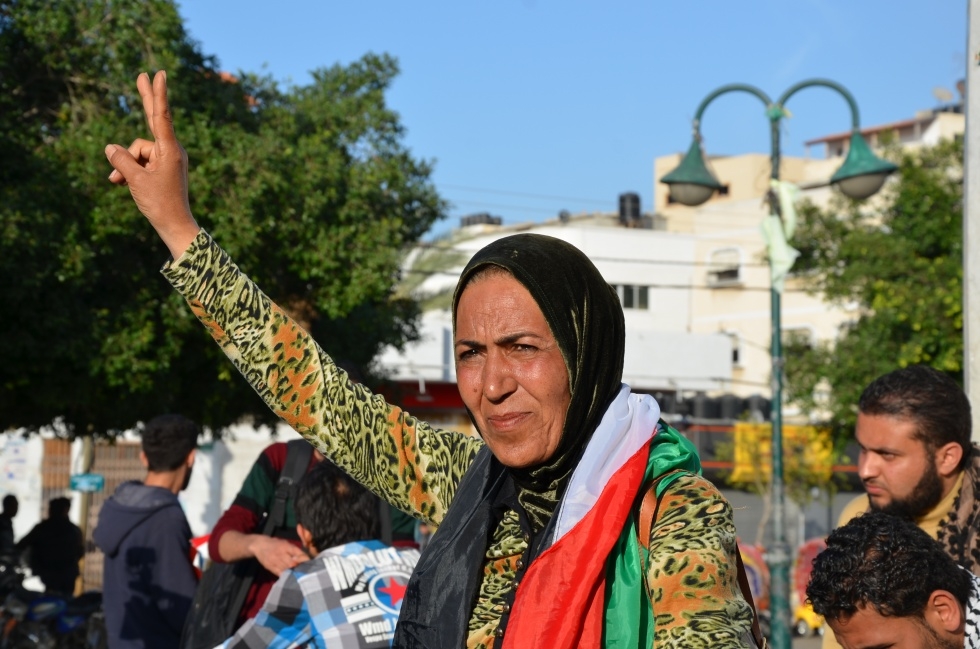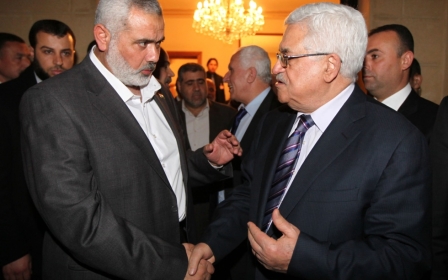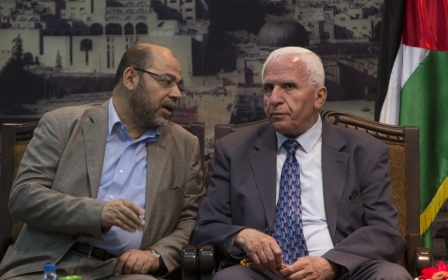Cautious optimism, celebrations in Gaza over reconciliation

GAZA CITY - Palestinians in Gaza expressed happy shock as well as scepticism late Wednesday after the two main political factions governing the divided territories signed a reconciliation deal, the third agreement of its kind in so many years.
A unity government will be formed within six weeks by current Palestinian President Mahmoud Abbas and elections will be held within six months, Fatah and Hamas representatives announced.
A chanting crowd gathered in a square in central Gazan as the news of the agreement spread. Images of the celebrations can be seen in an accompanying Middle East Eye photo gallery.
“I swear to God the division is dead. The division is out of the house. My people are happy,” they sang. “Unity, freedom, dignity and humanity.”
Wearing a black and white keffiyeh and a Che Guevara t-shirt, Gaza resident Samah Ahmad told the MEE that she hadn’t believed an agreement would be signed until Wednesday.
“I will believe in reconciliation if I touch it on the ground,” Ahmad said. “We’re still looking for freedom. We’re still looking for humanity. We want to feel we’re one.”
“I will believe it when I see it,” she added.
Hamas and Fatah split violently in 2007, leaving the Islamist movement in control of Gaza and effectively splitting the Palestinian territory in two. Previous reconciliation deals signed in Cairo in 2011 and in Doha in 2012 have never been implemented.
A delegation from Abbas’s Fatah party arrived in Gaza for reconciliation talks late Tuesday. The delegates were delayed, waiting on Monday for permission to travel through the Erez border crossing, but were granted visas by Israel the following day.
Under the terms of the agreement, Palestinian President Mahmoud Abbas will head a new unity government to be formed in the next five weeks. Then, within six month, there will be an election that will decide the new president, members of the legislative council and leaders of the PLO.
A special PLO committee will also meet within five weeks to discuss what the agreement means for the organisation.
“I am happy to declare the end of the period of inter-Palestinian division,” Hamas Prime Minister Ismail Haniyeh told reporters at a press conference following the negotiations.
The deal means that the two sides will uphold previous reconciliation agreements made in Doha and Cairo, Haniyeh said.
“We agreed to implement all the articles that were agreed in the past,” he said.
There are a number of issues that Fatah and Hamas still need to iron out. The future of Hamas' security forces, created after the Islamist group seized control of the Gaza Strip violently in 2007, are unclear. Whether Hamas will dismantle the forces or allow them to be under the supervision and command of the Palestinian Authority’s security forces remains to be determined.
But on Wednesday, the focus in Gaza was largely on celebration. Gazans set off fireworks and fired celebratory gunshots in the streets late into the evening. Along with those who gather in the central square, many Gazans crowded around Haniyeh’s home, which joins Al-Shati refugee camp near the beach, and watched the live signing of the agreement from broadcast trucks crowding the area.
One of the celebrants, Gazan journalist Sami Ajrami, has been restricted from leaving Gaza for seven years,even though he works for international media organisations. He said he believes that the latest deal will free up the strangled Gazan economy and allow him up to travel – if only to Egypt.
“We’ve been collectively punished by Israel and international communities, because they’re not dealing with Hamas,” Ajrami said.
Ajrami was visibly excited by the deal, racing around with his phone, taking calls from media outlets across the world, and speaking in hurried Arabic, English and Hebrew.
“It’s the first time a huge PLO delegation has come to Gaza to discuss things from an optimistic point-of-view," he said.
Fellow Gazan, Rehab Kenan, who also came out to the streets to see Wednesday's signing, wrapped a Palestinian flag around herself and posed for local media while making a peace sign.
“We’ve been waiting a long time, years for this to happen,” Kenan said. “We thank our leaders for the happiness they have brought us."
Kenan has two sons and said she believed the reconciliation could bring jobs for them and brighten their future.
“We wish the reconciliation to be a continuous one, congratulations to Gaza, there have been eight generations waiting for this,” she said.
Along with excitement, some Gazans expressed measured scepticism about the ability of the agreement to change their challenges. Gaza has been economically crippled by the closure of tunnels between Egypt and the enclave.
“Gaza needs everything, not only the economy,” said Ahmad, another chanter in the square. “We need health care. We need the borders to be open and we need freedom of movement.
“Societal reconciliation is more important that political reconciliation, because we believe that the leaders can have a good relationship, but the reconciliation should be with the people themselves.”
The reconciliation drew an angry reaction from Israeli Prime Minister Benjamin Netanyahu and will likely put futher strain on the Palestinian-Israeli peace process.
Netanyahu told US Secretary of State John Kerry that the unity deal showed Abbas was not interested in peace.
“This evening as talks are still ongoing about extending the negotiations,” he said, “Abu Mazen has chosen Hamas and not peace. Whoever choses Hamas does not want peace.”
He called an emergency meeting of his security Cabinet for Thursday morning to discuss Israel’s steps following the reconciliation.
Palestinians on the street, however, disagreed with Netanyahu’s assessment, saying unity with the Palestinian people was the biggest step toward peace.
Munib Ajrami told MEE that Palestinians need to work out their own internal factions before any peace would be real.
“This is the first step and Israel shouldn’t be seeing this in a negative light,” Ajrami said. “It’s an important step for us.”
Middle East Eye propose une couverture et une analyse indépendantes et incomparables du Moyen-Orient, de l’Afrique du Nord et d’autres régions du monde. Pour en savoir plus sur la reprise de ce contenu et les frais qui s’appliquent, veuillez remplir ce formulaire [en anglais]. Pour en savoir plus sur MEE, cliquez ici [en anglais].




